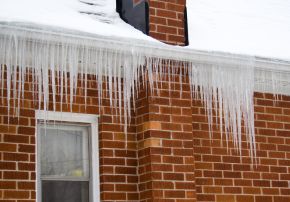 Winter weather brings snow, ice, and fluctuating temperatures that can wreak havoc on your home — especially your roof. One major hazard to watch for is ice dams. Left unchecked, ice dams can lead to costly roof repairs, water damage, and even structural issues.
Winter weather brings snow, ice, and fluctuating temperatures that can wreak havoc on your home — especially your roof. One major hazard to watch for is ice dams. Left unchecked, ice dams can lead to costly roof repairs, water damage, and even structural issues.
What is an Ice Dam?
An ice dam is a ridge of ice that forms at the edge of a roof and prevents melting snow from draining properly. This trapped meltwater can work its way under your shingles and into your home, causing structural or water damage to your ceilings, walls, and more.
What Causes Ice Dams?
Ice dams occur when temperature differences on your roof cause melting snow to refreeze at the eaves. As snow melts and water flows from warmer areas of the roof to its colder edges, the water refreezes and gradually forms a ridge of ice. Key contributors to ice dam formation include:
- Inadequate ventilation: Improper airflow allows warm air to accumulate in the attic.
- Poor attic insulation: Heat escapes from your home, warming the roof and causing snow to melt.
- Air leaks: Gaps around vents, chimneys, and other fixtures let warm air escape.
Do Ice Dams Cause Damage?
The weight of an ice dam can strain your roof, but that’s only the beginning of the problems they can create. Here are some common issues related to ice dams:
- Shingle damage: Ice dams can lift shingles as they form and expand, compromising their protective seal.
- Roof and gutter stress: The weight of ice dams can damage your roof and gutters, and in some cases, even pull gutters off your house.
- Water intrusion: Meltwater can seep under shingles, causing damage to your walls, insulation, floors, and ceilings.
- Mold formation: Trapped moisture from water intrusion creates an environment where mold can grow and thrive.
How do I Spot an Ice Dam?
Ice dams can easily go unnoticed, but these warning signs often indicate a potential problem:
- Icicles on the roof or gutters: Icicles form under similar conditions that allow ice dams to take hold.
- Snow buildup: A clear roof higher up with snow and ice buildup near the roof’s edge suggests uneven roof temperatures.
- Leaks or water stains: Damage to interior walls could be the result of water seeping in through compromised shingles.
How do I Remove an Ice Dam?
If you notice any warning signs, prompt ice dam removal can help prevent further damage. Here are a few quick fixes you can try to address the problem:
- Use a roof rake: Remove snow from the roof’s edge to minimize the source of melting water.
- Apply calcium chloride: Use a de-icing product designed for roofs. Avoid rock salt, which can damage paint and metal.
- Install heated cables: Mount temporary heating cables along the edge of your roof and through the downspout to create channels for proper water runoff.
If the situation is severe, it’s best to leave the ice dam removal to the professionals. Chipping away at ice dams can damage shingles and increase the chance of leaks. Plus, working on a roof in winter conditions can be dangerous. A professional has the tools and expertise to handle the job safely and effectively.
How can I prevent an Ice Dam?
Getting rid of ice dams permanently is simple in theory: keep the entire roof the same temperature as the eaves. Achieving this requires proper airflow, insulation, and ventilation. Here are a few long-term solutions to help reduce or eliminate ice dams:
- Improve insulation: Add insulation to the attic floor to keep heat from escaping through the attic.
- Enhance ventilation: Install soffit and ridge vents to regulate attic temperatures. Baffles may be necessary to improve air circulation.
- Stop air leaks: Seal any gaps around vents, electrical cables, chimneys, and recessed lighting to keep warm air inside your home.
- Keep gutters clear: Regularly remove leaves, sticks, and other debris from gutters and downspouts to allow proper drainage of melting snow.
- Remove snow buildup: Keep snow on your roof to a minimum by using a roof rake, especially after a heavy snowfall.
- Cap the attic hatch: Insulate and weatherstrip attic hatches to keep warm air from leaking into the attic.
- Exhaust properly: Ensure that exhaust ducts, including kitchen, bathroom, and dryer vents, lead outdoors through either the roof or walls, but never through the soffit.
used with permission from Westfield Insurance